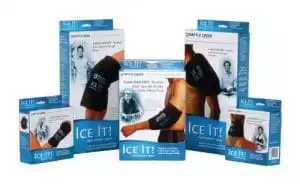Medical Ice Packs
Reduce Pain and Inflammation With Medical Ice Packs
When injuries strike, sometimes the best approach is to use ice on the area. By cooling the injured tissue down, you reduce the swelling and pain associated with the injury. Ice and cool temperatures can also reduce inflammation in other painful conditions like migraine, fibromyalgia, and Rheumatoid Arthritis for some. Medical ice packs are a simple and effective way to treat minor aches and pains or injuries right at home.
When Ice is Indicated
Ice is indicated for the relief of pain and the treatment of mild to moderate aches and pains and in the first 24 to 48 hours after a mild to moderate injury.
To use your ice pack:
- Apply the ice pack against the skin evenly
- Apply slight pressure to the affected area
- Keep the compress on for no more than 10 minutes
- Remove the compress for 15 minutes
- Continue this cycle to manage your condition
- If pain increases or skin whitens, stop immediately
Never place medical ice packs directly against this skin. It is possible to experience frostbite and damage healthy tissue with prolonged ice-to-skin contact. Instead, wrap the ice pack in a thin layer of fabric. A dish towel or hand towel usually works quite well.
Be cautious of using ice (or heat) in patients who are circulation-compromised. The reduced cardiovascular activity may result in faster cooling, so frostbite can occur at a much faster rate.
Choosing Your Ice Pack
Ice may seem like a simple treatment option, but you can buy medical ice packs in a variety of styles. Choosing the right style is imperative if you want to gain the most benefit from icing an injury or pain point.
Gel Ice Packs
Use gel ice packs to relieve pain on curved, uneven body surfaces. Gel ice packs don’t freeze completely, but depending on the brand, may retain cooling for up to eight hours. Store them in the freezer until needed.
Reusable Ice Packs
Use reusable ice packs for quick and easy access to cooling from anywhere with a refrigerator or freezer. Choose from a variety of sizes and material s to best suit your injury or treatment needs.
Disposable Ice Packs
Choose disposable ice packs for on-the-go access to medical cooling. Store them in a backpack, with camping gear, in your vehicle dash, or even at work. When needed, simply bend them to activate the cooling.
Cold Sacks
Unlike other medical ice packs, cold sacks don’t require a freezer or other cold storage method. A simple fabric or canvas bag with a lid at the top provides storage for ice cubes. Fill and empty the sack as needed.
ACE Cold Packs
Made from ACE bandage material, ACE cold packs come in a variety of styles. Store them in the freezer when not in use. The flexible outer fabric molds to your skin for maximum contact and full cooling benefits.
Life is complicated. When injuries and pain strike, cooling is often an effective and easy way to relieve it without medication. Still not sure whether ice is right for your situation? Contact our pharmacy for a consultation.
Showing the single result
-
View Product
Ice Packs #1

 info@burtsrx.com
info@burtsrx.com
